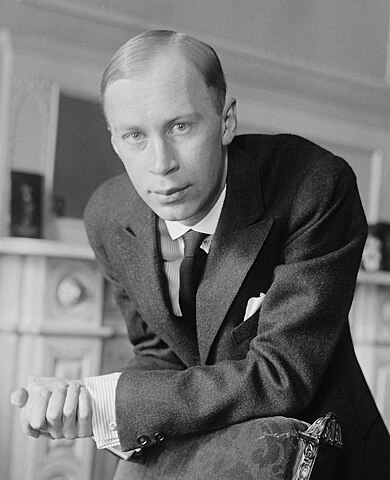Home
> Piano Works
> S.Prokofiev

Sergei Sergeyevich Prokofiev
1891-1953
Born in 1891 in the southwestern part of the Russian Empire (now Donetsk Oblast, Ukraine). Prokofiev, who received his musical education from his mother, showed talent from an early age, studying composition, piano, conducting and organ at the St. Petersburg Conservatory from 1904 to 1916. During this student life, he met his lifelong friends N.Myaskovskii (1881-1950) and B.Asafiev (B.Asafiev 1884-1949), in addition, he performed his own works and made musical debut St Petersburg Evenings of Contemporary Music.
After the Russian Revolution, he left Russia in 1918 and went to America. He then moved to Berlin, Paris, and continued his life outside Russia. Prokofiev, who continued to compose vigorously during his time abroad, produced after and other large-scale works such as Symphonies No. 2-4, Piano Concertos No. 3-5, and the opera 《The Love for Three Oranges, Op. 33》.
In 1935, as the world fell into recession, Prokofiev, who had lost the opportunity to perform large-scale works such as operas in Europe and the United States, headed to Russia again. Even after returning to Russia, he continued to compose music enthusiastically, producing works that continue to shine as masterpieces, such as Piano Sonata No. 6-8, the ballet 《Romeo and Juliet》, and the symphonic story 《Peter and the Wolf》. After returnd to Russia, He has also produced works that are pro-Russian authorities. His diverse musical activities also extend to film music, and he has composed music for famous films such as Eisenstein’s《Alexander Nevsky》 and 《Ivan the Terrible》.
Prokofiev’s musical career seemed to be going smoothly, but then in 1948, a government campaign called “criticism of Zhdanov” took place. Simply put, it is an activity to “prohibit avant-garde, difficult-to-understand music”. Stalin and the secretary, Zhdanov loved music and were well versed in it. Thus they tried to completely eliminate music that they could not understand and that did not fit their policy, calling it “unsocialist”. Prokofiev was also targeted by the government, and seven of his works were banned. He was in financial difficulty, had debts, and suffered from a worsening chronic disease, but he did not stop writing even in his later years, such as completing Symphony No. 7 the year before he died.
In 1953 he died of a brain hemorrhage.
Although Prokofiev’s works are an important repertoire in modern times, it is difficult to express in words that they have a style that makes them “this”. This is probably because he is not a composer who has become a turning point in the history of music, such as establishing new grammars and forms of composition, or belonging to an avant-garde group. However, his works have distinct characteristics, and the more you listen to them, the more your individuality shines. I thought it was a “grotesque” style from the way the harmonies, rhythms, and sounds clash, but according to Prokofiev himself, it is a “scherzo” of “jokes, laughter, and ridicule.” Well, of course, this is only one aspect, but it makes me think that a kind of brightness and cheerfulness in Prokofiev’s work is due to these points. A collection of masterpieces, both dark and bright, is enough to prove that Prokofiev is one of the great composers of the 20th century.
[Q. What is your favorite piece? ]
mezzopiano)
〈Violin Sonata No. 2 Op. 94 bis (Flute Sonata Op. 94)〉.
I heard the Violin Sonata first, but when heard the flute version, I fell in love with it. Ah, isn’t this piece for the flute~! (haha)
Also, 《Music for Children, Op.65》 is a gem. As the name suggests, it’s for children, but all the songs are easy to play and interesting.
When I was a child, I didn’t know about him (due to my lack of study, of course), but there’s a song that I either listened to or played. Even if After all, I think again that this is the reason why I am a great composer who can write songs that are engraved in my heart.
suketto)
Piano Sonata No. 2, 3, and 6. No reason, I like what I like!!
|Piano Solo
Piano Sonata No. 1 in F minor, Op. 1
Piano Sonata No. 2 in D minor, Op. 14
Piano Sonata No. 3 in A minor, Op. 28
Piano Sonata No. 4 in C minor, Op. 29
Piano Sonata No. 5 in C major (original version), Op. 38 / (revised version), Op. 135
Piano Sonata No. 6 in A major, Op. 82
Piano Sonata No. 7 in B♭ major, Op. 83
Piano Sonata No. 8 in B♭ major, Op. 84
Piano Sonata No. 9 in C major, Op. 103
Piano Sonata No. 10 in E minor, Op. 137 (unfinished)
Toccata in D minor, Op. 11
Sarcasms, five pieces for piano, Op. 17
Visions fugitives, 20 pieces for piano, Op. 22
Music for Children, 12 easy pieces, Op. 65
|References
〈Website〉